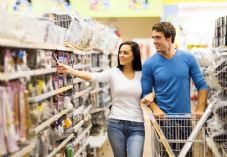UK DIY News
BRC: Retail Sales Show Signs Of Recovery But Little Cause For Optimism

The latest retail sales data from the BRC covers the four weeks from 5th July - 1st August:
- On a Total basis, sales increased by 3.2% in July, against an increase of 0.5% in July 2019*, It is above the 3-month average growth of 0.4% and the 12m average decline of 1.9%. This is the second consecutive month of growth since the start of the pandemic.
- In July, UK retail sales increased 4.3% on a Like-for-like basis from July 2019, when they had increased 0.3% from the preceding year*. In July, Like-for-like has been measured EXCLUDING temporarily closed stores but including Online sales.
- Over the three months to July, In-Store sales of Non-Food items declined 29.3% on a Total and 11.3% on a Like-for-like basis. This is worse than the 12-month Total average decline of 17.7%. For July, the like-for-like excluding temporarily closed stores remained in decline.
- Over the three months to July, Food sales increased 8.2% on a Like-for-like basis and 6.1% on a Total basis. This is This is the highest since June 2009 and higher than the 12-month Total average growth of 3.2%. For the month of July, Food was in growth year-on-year.
- Over the three-months to July, Non-Food retail sales increased by 7.9% on a like-for-like basis and declined 4.3% on a Total basis. This is above the 12-month Total average decline of 6.1%. For the month of July, Non-Food was in growth year-on-year.
- Online Non-Food sales increased by 41.0% in July, against a growth of 3.7% in July 2019*. This is below the 3-mth average of 49.7% but above the 12-mth average of 19.9%.
- Non-Food Online penetration rate increased from 29.7% in July 2019 to 42.0% this July.
* Note 2020 is a 53-week year in the ONS calendar: as a result of the extra week in January 2020, the comparable 2019 performances cited here may differ from those published last year, due to the one-week shift in the comparison.
Helen Dickinson OBE, Chief Executive | British Retail Consortium
“July saw the second month of growth as lockdown measures eased and demand gradually began to return in some places. Many shops continued to struggle as footfall was down, with many people still reluctant to go out, and fewer impulse purchases. The strongest performance came from food, furniture and homeware, as consumers increasingly invest in their time at home, however, many shops, particularly in fashion, jewellery and beauty, are still struggling to survive. Online sales remained buoyant, slowing only slightly despite more shops reopening.”
“While the rise in retail sales is a step in the right direction, the industry is still trying to catch up lost ground, with most shops having suffered months of closures. The fragile economic situation continues to bear down on consumer confidence, with some retailers hanging by only a thread in the face of rising costs and lower sales. Rents are also continuing to accumulate and the next Quarter Rent Day could see many otherwise viable businesses fall into insolvency, costing stores, jobs and economic growth. The Government should adopt the proposal from landlords and tenants for a Property Bounceback Grant, which would deliver £7 billion in tax revenue to the Exchequer and save 375,000 jobs.”
Paul Martin, UK Head of Retail | KPMG
“The release of pent up demand continued in July, with total retail sales growing at 3.2% compared to the same month in 2019. Fortunes were heavily polarised though, and fashion sales continued to suffer despite the summer weather – even online.
“While social distancing restrictions have eased and our daily lives have started to return to a degree of normality, shoppers are still focussed on life at home for the most part. Online sales continue to remain prominent – accounting for over 40 per cent of sales – while food and home focussed categories like furniture, homewares and kitchen accessories remained among the strongest performers. With many of us continuing to work from home, sales of computing equipment soared too.
“September will be the real test for retailers this quarter, traditionally being a month of high volumes driven by the return to school after the holiday season. That said, with the furlough scheme unwinding and wider economic uncertainty set for the autumn, consumer anxiety will likely rise along with it. This will place more scrutiny on disposable income and make life even tougher for retailers.”
Food & Drink sector performance | Susan Barratt, CEO | IGD
“Following two months of exceptionally strong growth, food and grocery sales slowed notably in July, signalling a move towards more normal or pre-lockdown shopper behaviour. Alcohol sales are still contributing significantly to growth for supermarkets, but less so than in May and June.
“IGD’s Shopper Confidence Index remained low but stable in July albeit with regional variations; local lockdowns in the north of England have led to a significant decrease in confidence in this region, while morale has been boosted in Scotland. However, the economic impact of COVID-19 will be felt on shopper confidence going forward and retailers should prepare for increased focus on savvy shopping for the remainder of the year at least.”
Source : BRC
I find the news and articles they publish really useful and enjoy reading their views and commentary on the industry. It's the only source of quality, reliable information on our major customers and it's used regularly by myself and my team.











































